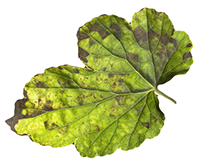Rush Lawn Care has several applications to rid your lawn of unwanted shrub diseases. See below for a brief list of some of the diseases we specialize in controlling. Declare victory over your lawn by requesting a FREE estimate today!

General and serious. Leaves have black spots with irregular margins. Leaflets yellow and drop off. Collect and remove fallen leaves. Fungicide is necessary in spring as leaves expand. Susceptible varieties must be protected with fungicides before disease is present for good control.

Phomopsis needle and twig - Serious in wet seasons. Needles, twigs and smaller branches turn brown to reddish-brown; gradually die back. Tiny black dots appear later on infected parts. May be confused with normal fall browning, winter injury, spider mites, etc. Prune or remove blighted plants. Spray fungicide.

Cankers are diseased areas of the bark. Many different kinds of fungi and a few bacteria may cause them. The outer bark may appear abnormal. Inner bark is brown and discolored. In time the bark may fall off. Leaves beyond the canker may yellow, scorch or die. Usually canker-causing pathogens can infect only hosts that have been injured or stressed. Trees in decline often loose branches to cankers. Management of canker disease includes avoiding unnecessary injuries and knowing and supplying the maintenance needs of the host to reduce stress.

General and serious. New shoots suddenly appear as if scorched by fire. Leaves cling to twigs. Cankers may be present on twigs and branches. Prune blighted parts in dormant season or in late summer or fall when weather is dry. Dip pruning tools in 70 percent alcohol or 10 percent household bleach between cuts. No chemical control suggested. Cultivars vary in susceptibility.

Leaves become thickened or fleshy galls that then turn pale green or white. The entire blossom may become a fleshy gall covered with a whitish bloom. Usually, chemical control is not warranted. Pick off and destroy galled parts, if feasible. If severe infection, you may apply the correct fungicide.

Leaf spots may be caused by a variety of fungal pathogens and a few bacterial ones. Anthracnose causes brown lesions on the leaves, in which tiny fruiting bodies may be seen with a hand lens. Anthracnose is a term used for a group of loosely related fungal diseases that often cause blotches along leaf veins or leaf spots, and can cause twig blights and cankers. Bacterial leaf spot has small, water soaked circular spots that eventually turn brown to purple. Twigs may become girdled, resulting in a blight. Prune and remove affected parts.

Above-ground symptoms depend on the level of infestation. At high levels, there may be stunting, yellowing and an unthrifty appearance. Symptoms may be confused with mineral deficiency, drought, herbicide injury or other soil-borne diseases. Roots have small to large galls and may be excessively branched. Dark brown to black lesions on roots, to overall browning. Roots are usually discolored. Control recommendations depend on species present.

Powdery white moldy patches on leaves. Remove badly affected shoots. Prune to thin out branches. Spray with fungicide when mildew appears.

Terminal buds and leaves turn brown. Evergreen leaves roll up and droop as though in a winter condition. Cankers are formed on the stems. If stems are girdled, all parts above will wilt and die. Prune and remove affected branches.

Usually, plants slowly decline in vigor and die. Brownish cortical tissues in the root and crown areas. Often associated with wet feet. Maintain good drainage and vigor.

Root Rot can be caused by a wide number of fungi. Few of these can be controlled in the landscape, especially on large trees. With Phytophthora root rot, the leaves wilt. Growth is stunted. Fine roots decay and cankers may develop at the base of the stem. Fungicides are available, but their use generally is not recommended for established planting. Remove and destroy affected plants. If practical, improve soil drainage and replant with a more tolerant variety.

Serious in wet weather. Dull, olive to black velvety or scurfy spots on leaves. Leaves may yellow and fall off. May also appear on fruit. Varieties vary in susceptibility.

Common and severe in wet springs on shaded or crowded plants. Immature leaves turn black and die. Flower buds may be entirely black. Spots and blotches on leaves. Annually prune for good air circulation. Prune out blighted portions. Disinfect tools between cuts. Avoid over fertilization with nitrogenous materials. Control borers.

Leaves become pale, wilt, and fall early, starting at base and spreading upward. Stems show brownish green streaks under bark. Branch die back. Dig up and remove affected plants, roots and all. Avoid replanting in same spot for 5-6 years and/or replant with resistant species.